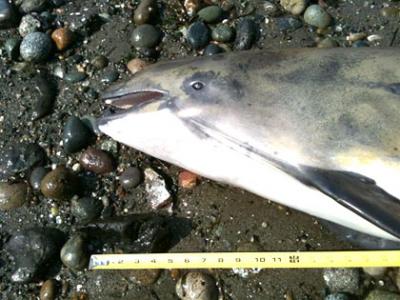
Porpoise CSI

With considerable help from some observant Islanders, your VHP Coordinator responded to an unusual cetacean stranding on July 6. Bob Lane called me that morning about a deceased Harbor Porpoise on the beach at Sandy Shores. His emailed photos showed that the fresh-dead porpoise was in pristine condition -- a rarity.
I initially examined the sadly beautiful adult female porpoise. She was skinny and she had diatomaceous growth, an algal coating, on her skin. I have not previously seen a stranded porpoise with such growth. Tooth rake marks and old, healed injuries indicated that the plucky porpoise survived a Transient killer whale attack. The carcass, however, showed no overt signs of recent physical trauma, such as a ship strike. The cause of death was not immediately apparent. A thorough necropsy and other lab work will identify factors that contributed to the porpoise’s death.
Marine mammal carcasses in excellent condition are highly sought-after for research. Biologists at National Marine Fisheries Service (NMFS) and Cascadia Research Collective were notified of the exceptional find. A biologist who conducts long-term studies on Harbor Porpoises came from NMFS Northwest Fisheries Science Center in Seattle to collect the valuable specimen. I am grateful to Mr. Lane for his above-and-beyond assistance in preserving the porpoise. We sat with her, wetting her skin and shooing away scavengers, until the biologist arrived.
After decades of decline, the shy Harbor Porpoise seems to be rebounding in lower Puget Sound; sightings have increased in the last decade. Harbor Porpoises, our smallest resident cetaceans, are susceptible to entanglement and drowning in fishing nets. Decreased fishing with large nets in Puget Sound ostensibly benefits the Harbor Porpoise.
The VHP seldom gets calls about Harbor Porpoises in local waters. Islanders are more likely to see and report the larger, black and white Dall’s Porpoises. Finding an intact carcass of either porpoise species on Vashon-Maury is uncommon. Finding one dead for just a few hours is astonishing. Thank you, Bob!
Gauntness and diatomaceous growth suggest our Sandy Shores porpoise was ailing in her final days. She could have succumbed to an infection, perhaps from the fungus Cryptococcus gattii, a spooky emerging pathogen in the Pacific Northwest. Since 1999, C. gattii has been found in dozens of dead porpoises. Signs of C. gattii infection include pneumonia-ravaged lungs and tumor-filled, swollen organs. The disease is contracted by inhaling the fungus, though C. gattii infection is still rare in humans and treatable with anti-fungal meds.
C. gattii, a member of the yeast family, may be a harbinger of global warming. One theory about its presence on Vancouver Island is that it arrived on the bark of eucalyptus trees imported from Australia. Another theory is that C. gattii lurked there already and warmer summers allowed it to flourish. What spooks me: if C. gattii infects porpoises, it could infect killer whales, too.
Back to stranding -- Odin and I are authorized marine mammal stranding responders; so is T Yamamoto of Wolftown. Several federal laws (e.g., Marine Mammal Protection Act, Endangered Species Act) protect marine mammals. It is illegal for unauthorized persons to touch, feed or disturb marine mammals. Collecting or possessing marine mammal parts from dead strandings is also illegal.
Most of our stranding calls are about pinnipeds – seals and sea lions. Again, fresh-dead specimens are the most promising for research, so we appreciate timely reports. Little or nothing can be gleaned from deteriorated, gooey carcasses; they typically stay on the beach to return to nature.
Harbor Seal pupping season is underway in Puget Sound. Mother seals leave their pups alone for hours on shore, using beaches, boat ramps, and bulkheads. If humans and dogs harass a seal pup or prevent the mother seal from returning to care for her baby, she might abandon the pup. Ideally, maintain a 100-yard distance from seals.
Please support the work of the Vashon Hydrophone Project (VHP): REPORT LOCAL WHALE SIGHTINGS ASAP TO 463-9041, as well as sick, injured, or dead marine mammals on Island beaches. Do not intervene with marine mammals by yourself, without clear direction from an authorized stranding responder. Many situations involving seal pups can be resolved with a phone call. Check for updates at Vashonorcas.org and send photos to Orca Annie at Vashonorcas@aol.com.
- Login to post comments
